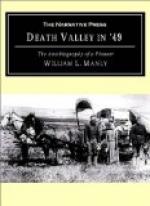One day, after the wagons were abandoned these German fellows were marching along alone with their packs on their backs in the warm sun, suffering very much for want of water and food, when one of them sat down on a hill-side in pretty nearly absolute despair, while the other man went down into a ravine hoping to find a puddle of water in the rocky bottom somewhere, though it was almost a forlorn hope. All at once he called out to his partner on the hill—“John, come down here and get some of this gold. There is a lot of it.” To this poor John Galler only replied:—“No, I won’t come. I don’t want any gold, but I would like very much to have some water and some bread.” And so they left the valuable find and slowly walked on, pulling through at last with the rest of them, and reaching Los Angeles.
The man who found the gold went to the Mission of San Luis Rey and started a small clothing store, and some time afterward was killed. John Galler settled in Los Angeles and established a wagon shop in which he did a successful business. He was an honest, industrious man and the people had great confidence in him. He often told them about what his partner had said about finding the gold in the desert, and the people gave him an outfit on two or three occasions to go back and re-locate the find, but he did not seem to have much idea of location, and when he got back into the desert again things looked so different to him that he was not able to identify the place, or to be really certain they were on the same trail where his companion found the gold.
The Author saw him in 1862 and heard what he had to say about it, and is convinced that it was not gold at all which they saw. I told him that I more than suspected that what he saw was mica instead of gold and that both he and his partner had been deceived, for more than one man not used to gold had been deceived before now. “No sir!” said he, “I saw lots of gold in Germany, and when I saw that I knew what it was.” The Author went back over that trail in 1862 and sought out the German on purpose to get information about the gold. He could not give the name of a single man who was in the party at that time, but insisted that it was gold he saw and that he knew the trail.
The Author was able to identify with reasonable certainty the trails followed by the different parties, but found no signs of gold formation except some barren quartz, and this after an experience of several years in both placer and quartz mines. So honest John Galler’s famous placer mine still remains in the great list of lost mines, like the Gunsight Lead and other noted mines for which men have since prospected in vain.




